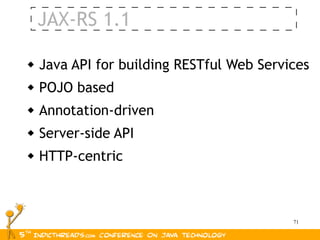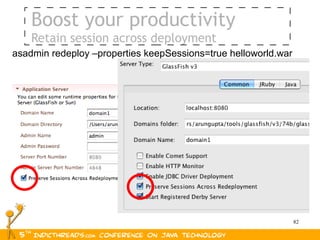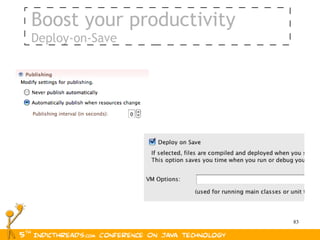Java EE 6 - Deep Dive - Indic Threads, Pune - 2010
- 1. Jagadish Ramu Sun Microsystems Java EE 6 - Deep Dive 1
- 2. The following/preceding is intended to outline our general product direction. It is intended for information purposes only, and may not be incorporated into any contract. It is not a commitment to deliver any material, code, or functionality, and should not be relied upon in making purchasing decisions. The development, release, and timing of any features or functionality described for Oracle’s products remains at the sole discretion of Oracle. 2
- 3. Compatible Java EE 6 Impls Today: Announced: 3
- 4. Goals for the Java EE 6 Platform Flexible & Light-weight Web Profile 1.0 Pruning: JAX-RPC, EJB 2.x Entity Beans, JAXR, JSR 88 Extensible • Embrace Open Source Frameworks Easier to use, develop on • Continue on path set by Java EE 5 4
- 5. Java EE 6 Web Profile 1.0 Fully functional mid-sized profile • Actively discussed in the Java EE 6 Expert Group and outside it • Technologies • Servlets 3.0, JSP 2.2, EL 2.2, Debugging Support for Other Languages 1.0, JSTL 1.2, JSF 2.0, Common Annotations 1.1, EJB 3.1 Lite, JTA 1.1, JPA 2.0, Bean Validation 1.0, Managed Beans 1.0, Interceptors 1.1, Context & Dependency Injection 1.0, Dependency Injection for Java 1.0 5
- 6. Java EE 6 - Done 09 Specifications approved by the JCP Reference Implementation is GlassFish v3 20 TCK ec D 6
- 7. Java EE 6 Specifications The Platform Java EE 6 Web Profile 1.0 Managed Beans 1.0 7
- 8. Java EE 6 Specifications New Contexts and Dependency Injection for Java EE (JSR 299) Bean Validation 1.0 (JSR 303) Java API for RESTful Web Services (JSR 311) Dependency Injection for Java (JSR 330) 8
- 9. Java EE 6 Specifications Extreme Makeover Java Server Faces 2.0 (JSR 314) Java Servlets 3.0 (JSR 315) Java Persistence 2.0 (JSR 317) Enterprise Java Beans 3.1 & Interceptors 1.1 (JSR 318) Java EE Connector Architecture 1.6 (JSR 322) 9
- 10. Java EE 6 Specifications Updates Java API for XML-based Web Services 2.2 (JSR 224) Java API for XML Binding 2.2 (JSR 222) Web Services Metadata MR3 (JSR 181) JSP 2.2/EL 2.2 (JSR 245) Web Services for Java EE 1.3 (JSR 109) Common Annotations 1.1 (JSR 250) Java Authorization Contract for Containers 1.3 (JSR 115) Java Authentication Service Provider Interface for Containers 1.0 (JSR 196) 10
- 11. Servlets in Java EE 5 At least 2 files <!--Deployment descriptor /* Code in Java Class */ web.xml --> package com.sun; <web-app> public class MyServlet extends <servlet> HttpServlet { <servlet-name>MyServlet public void doGet(HttpServletRequest </servlet-name> req,HttpServletResponse res) <servlet-class> com.sun.MyServlet { </servlet-class> ... </servlet> <servlet-mapping> } <servlet-name>MyServlet </servlet-name> ... <url-pattern>/myApp/* </url-pattern> } </servlet-mapping> ... </web-app> 11
- 12. Servlets 3.0 (JSR 315) Annotations-based @WebServlet package com.sun; @WebServlet(name=”MyServlet”, urlPatterns={”/myApp/*”}) public class MyServlet extends HttpServlet { public void doGet(HttpServletRequest req, HttpServletResponse res) <!--Deployment descriptor web.xml --> { ... <web-app> <servlet> } <servlet-name>MyServlet</servlet-name> <servlet-class> com.sun.MyServlet </servlet-class> </servlet> <servlet-mapping> <servlet-name>MyServlet</servlet-name> <url-pattern>/myApp/*</url-pattern> </servlet-mapping> ... </web-app> http://blogs.sun.com/arungupta/entry/totd_81_getting_started_with 12
- 13. Servlets 3.0 Annotations-based @WebServlet @WebServlet(name="mytest", urlPatterns={"/myurl"}, initParams={ @WebInitParam(name="n1", value="v1"), @WebInitParam(name="n2", value="v2") } ) public class TestServlet extends javax.servlet.http.HttpServlet { .... 13 }
- 14. Servlets 3.0 Annotations-based @WebListeners <listener> <listener-class> server.LoginServletListener </listener-class> </listener> package server; . . . @WebListener() public class LoginServletListener implements ServletContextListener { 14
- 15. Servlets 3.0 Annotations-based @WebFilter <filter> <filter-name>PaymentFilter</filter-name> <filter-class>server.PaymentFilter</filter-class> <init-param> <param-name>param1</param-name> <param-value>value1</param-value> package server; </init-param> . . . </filter> @WebFilter( <filter-mapping> <filter-name>PaymentFilter</filter-name> filterName="PaymentFilter", <url-pattern>/*</url-pattern> InitParams={ </filter-mapping> @WebInitParam( <filter-mapping> <filter-name>PaymentFilter</filter-name> name="param1", <servlet-name>PaymentServlet</servlet-name> value="value1") <dispatcher>REQUEST</dispatcher> } </filter-mapping> urlPatterns={"/*"}, servletNames={"PaymentServlet"}, dispatcherTypes={DispatcherType.REQUEST} ) public class PaymentFilter implements Filter { . . . 15
- 16. Servlets 3.0 Asynchronous Servlets Useful for Comet, long waits Must declare @WebServlet(asyncSupported=true) AsyncContext context = request.startAsync(); context.addListener(new AsyncListener() { … }); context.dispatch(“/request.jsp”); //context.start(Runnable action); ... context.complete(); //marks completion 16 http://blogs.sun.com/arungupta/entry/totd_139_asynchronous_request_processing
- 17. Servlets 3.0 Extensibility Plugin libraries using web fragments Modular web.xml Bundled in framework JAR file in META-INF directory Zero-configuration, drag-and-drop for web frameworks • Servlets, servlet filters, context listeners for a framework get discovered and registered by the container Only JAR files in WEB-INF/lib are used 17
- 18. Servlets 3.0 Extensibility <web-fragment> <filter> <filter-name>wicket.helloworld</filter-name> <filter-class>org.apache.wicket.protocol.http.WicketFilter</filter-class> <init-param> <param-name>applicationClassName</param-name> <param-value>...</param-value> </init-param> </filter> <filter-mapping> <filter-name>wicket.helloworld</filter-name> <url-pattern>/*</url-pattern> </filter-mapping> </web-fragment> http://blogs.sun.com/arungupta/entry/totd_91_applying_java_ee 18
- 19. Servlets 3.0 Resource Sharing Static and JSP no longer confined to document root of the web application May be placed in WEB-INF/lib/ [*.jar]/META-INF/resources Resources in document root take precedence over those in bundled JAR myapp.war WEB-INF/lib/catalog.jar /META-INF/resources/catalog/books.html http://localhost:8080/myapp/catalog/books.html 19
- 20. EJB 3.1 (JSR 318) Package & Deploy in a WAR Java EE 5 Java EE 6 foo.war foo.ear WEB-INF/classes foo_web.war com.sun.FooServlet com.sun.TickTock WEB-INF/web.xml com.sun.FooBean WEB-INF/classes com.sun.FooHelper com.sun.FooServlet com.sun.TickTock foo_ejb.jar com.sun.FooBean web.xml ? com.sun.FooHelper http://blogs.sun.com/arungupta/entry/totd_95_ejb_3_1 20
- 21. EJB 3.1 @Stateless public class App { public String sayHello(String name) { return "Hello " + name; } } 21
- 22. EJB 3.1 No interface view – one source file per bean Only for Local and within WAR Required for Remote No location transparency Component initialization in @PostConstruct No assumptions on no-arg ctor 22
- 23. Java EE 6 Namespaces Global java:global/..(for all applications) Application scoped java:app/.. (visibile only for the app.) App-1 binds an Object by name “java:app/myObject”, App-2 cannot see it. All modules of the app has visibility. mod-1, mod-2 of app-1 can see “java:app/myObject” 23
- 24. Java EE 6 Namespaces Module Scoped java:module/.. (visible only for the module) App-1 has module-1 and module-2 Module-1's namespace not accessible by module-2 All components of the module has visibility Component 24
- 25. EJB 3.1 Portable Global JNDI Name Syntax Portable Global Application/Module-scoped Derived from metadata such as name, component name etc. 25
- 26. EJB 3.1 Portable Global JNDI Name Syntax Base name of ejb-jar/WAR Only within EAR (or ejb-jar.xml/web.xml) Base name of EAR (or application.xml) java:global[/<app-name>]/<module-name>/<bean-name> [!<fully-qualified-interface-name>] Unqualified name of the bean class Annotation/name attribute • Until now, only java:comp Or ejb-jar.xml • Local & Remote business • No-interface • Also in java:app, java:module 26
- 27. EJB 3.1 Portable Global JNDI Name Syntax package com.acme; @Stateless public class FooBean implements Foo { ... } FooBean is packaged in fooejb.jar java:global/fooejb/FooBean java:global/fooejb/FooBean!com.acme.Foo java:app/fooejb/FooBean java:app/fooejb/FooBean!com.acme.Foo java:module/FooBean java:module/FooBean!com.acme.Foo 27
- 28. EJB 3.1 Embeddable API – Deploy the Bean public void testEJB() throws NamingException { EJBContainer ejbC = EJBContainer.createEJBContainer(); Context ctx = ejbC.getContext(); App app = (App) ctx.lookup("java:global/classes/App"); assertNotNull(app); String NAME = "Duke"; String greeting = app.sayHello(NAME); assertNotNull(greeting); assertTrue(greeting.equals("Hello " + NAME)); ejbC.close(); } http://blogs.sun.com/arungupta/entry/totd_128_ejbcontainer_createejbcontainer_embedded 28
- 30. EJB 3.1 Singleton Beans One instance per app/VM, not pooled Useful for caching state CMT/BMT Access to container services for injection, resource manager, timers, startup/shutdown callbacks, etc. Enable eager initialization using @Startup Always supports concurrent access Define initialization ordering using @DependsOn @Singleton public class MyEJB { . . . 30 }
- 31. EJB 3.1 Asynchronous Session Beans Control returns to the client before the container dispatches invocation to a bean instance @Asynchronous – method or class Return type – void or Future<V> Transaction context does not propagate REQUIRED → REQUIRED_NEW Security principal propagates 31
- 32. EJB 3.1 Asynchronous Session Beans – Code Sample @Stateless @Asynchronous public class SimpleAsyncEJB { public Future<Integer> addNumbers(int n1, int n2) { Integer result; result = n1 + n2; try { // simulate JPA queries + reading file system Thread.currentThread().sleep(2000); } catch (InterruptedException ex) { ex.printStackTrace(); } return new AsyncResult(result); } } http://blogs.sun.com/arungupta/entry/totd_137_asynchronous_ejb_a 32
- 33. EJB 3.1 Timers Automatically created EJB Timers Calendar-based Timers – cron like semantics Every Mon & Wed midnight @Schedule(dayOfWeek=”Mon,Wed”) 2pm on Last Thur of Nov of every year (hour=”14”, dayOfMonth=”Last Thu”, month=”Nov”) Every 5 minutes of every hour (minute=”*/5”, hour=”*”) Every 10 seconds starting at 30 (second=”30/10”) Every 14th minute within the hour, for the hours 1 & 2 am (minute=”*/14”, hour=”1,2”) 33
- 34. EJB 3.1 Timers Single persistent timer across JVMs Automatically created EJB Timers @Schedule(hour=”15”,dayOfWeek=”Fri”) Can be chained @Schedules({ @Schedule(hour=”6”,dayOfWeek=”Tue,Thu,Fri-Sun”), @Schedule(hour=”12”,dayOfWeek=”Mon,Wed”) }) May be associated with a TimeZone Non-persistent timer, e.g. Cache @Schedule(..., persistent=false) 34
- 35. EJB 3.1 EJB 3.1 Lite – Feature Comparison 35
- 36. Managed Beans 1.0 EJB CDI JSF JAX-WS JAX-RS JPA ... @Stateful @Managed @Web @Stateless @Named @Path @Entity ... Bean Service @Singleton @javax.annotation.ManagedBean 36
- 37. Managed Beans 1.0 POJO as managed component for the Java EE container JavaBeans component model for Java EE Simple and Universally useful Advanced concepts in companion specs Basic Services Resource Injection, Lifecycle Callbacks, Interceptors Available as @Resource / @Inject java:app/<module-name>/<bean-name> java:module/<bean-name> 37
- 38. Managed Beans 1.0 - Sample @javax.annotation.ManagedBean @Resource public class MyManagedBean { MyManagedBean bean; @PostConstruct public void setupResources() { // setup your resources } @Inject MyManagedBean bean; @PreDestroy public void cleanupResources() { // collect them back here } public String sayHello(String name) { return "Hello " + name; } } http://blogs.sun.com/arungupta/entry/totd_129_managed_beans_1 38
- 39. Java Persistence API 2 (JSR 317) Sophisticated mapping/modeling options Collection of basic types @Entity public class Person { @Id protected String ssn; protected String name; protected Date birthDate; . . . @ElementCollection @CollectionTable(name=”ALIAS”) protected Set<String> nickNames; } 39
- 40. Java Persistence API 2 Sophisticated mapping/modeling options Collection of embeddables @Embeddable public class Address { String street; String city; String state; . . . } @Entity public class RichPerson extends Person { . . . @ElementCollection protected Set<Address> vacationHomes; . . . } 40
- 41. Java Persistence API 2 Sophisticated mapping/modeling options Multiple levels of embedding @Embeddable public class ContactInfo { @Embedded Address address; . . . } @Entity public class Employee { @Id int empId; String name; @Embedded ContactInfo contactInfo; . . . 41 }
- 42. Java Persistence API 2 Sophisticated mapping/modeling options Improved Map support @Entity public class VideoStore { @Id Integer storeId; Address location; . . . @ElementCollection Map<Movie, Integer> inventory; } @Entity public class Movie { @Id String title; @String director; . . . } 42
- 43. Java Persistence API 2 Metamodel Abstract “schema-level” model over managed classes of a Persistence Context Entities, Mapped classes, Embeddables, ... Accessed dynamically EntityManager or EntityManagerFactory.getMetamodel() And/or statically materialized as metamodel classes Use annotation processor with javac 43
- 44. Java Persistence API 2 Metamodel Example @Entity public class Customer { @Id Integer custId; String name; ... Address address; @ManyToOne SalesRep rep; @OneToMany Set<Order> orders; } import javax.persistence.metamodel.*; @StaticMetamodel(Customer.class) public class Customer_ { public static SingularAttribute<Customer, Integer> custId; public static SingularAttribute<Customer, String> name; public static SingularAttribute<Customer, Address> address; public static SingularAttribute<Customer, SalesRep> rep; public static SetAttribute<Customer, Order> orders; } 44
- 45. Java Persistence API 2 Caching 1st-level Cache by PersistenceContext Only one object instance for any database row 2nd-level by “shared-cache-mode” ALL, NONE UNSPECIFIED – Provider specific defaults ENABE_SELECTIVE - Only entities with Cacheable(true) DISABLE_SELECTIVE - All but with Cacheable(false) Optional feature for PersistenceProvider 45
- 46. Java Persistence API 2 Much more ... New locking modes PESSIMISTIC_READ – grab shared lock PESSIMISTIC_WRITE – grab exclusive lock PESSIMISTIC_FORCE_INCREMENT – update version em.find(<entity>.class, id, LockModeType.XXX) em.lock(<entity>, LockModeType.XXX) Standard configuration options javax.persistence.jdbc.[driver | url | user | password] 46
- 47. Screencast - JPA 47
- 48. @DataSourceDefinition @DataSourceDefinition( name="java:global/MyApp/MyDataSource", className="org.apache.derby.jdbc.ClientDataSource" databaseName=”testdb”, serverName=”localhost”, portNumber=”1527”, user="dbuser", password="dbpassword" ) • Equivalents in DDs as <datasource-definition> element • Can be defined in Servlet, EJB, Managed Beans, Application Client and their DDs. • Can be defined in 'global', 'app', 'module', 'comp' scopes 48
- 49. Interceptors 1.1 Interpose on invocations and lifecycle events on a target class Defined Using annotations or DD Default Interceptors (only in DD) Class & Method Interceptors In the same transaction & security context Cross-cutting concerns: logging, auditing, profiling 49
- 50. Interceptors 1.1 - Code @InterceptorBinding @Retention(RetentionPolicy.RUNTIME) @Target({ElementType.METHOD, ElementType.TYPE}) public @interface MyInterceptorBinding { } @Interceptor @MyInterceptorBinding public class MyInterceptor { @AroundInvoke public Object intercept(InvocationContext context) { System.out.println(context.getMethod.getName()); System.out.println(context.getParameters()); Object result = context.proceed(); return result; } 50 . . .
- 51. Interceptors 1.1 – Sample Code @Interceptors(MyInterceptor.class) public class MyManagedBean { . . . } @Inject MyManagedBean bean; http://blogs.sun.com/arungupta/entry/totd_134_interceptors_1_1 51
- 52. Interceptors 1.1 – Sample Code @MyInterceptorBinding public class MyManagedBean { . . . } Single instance of Interceptor per target class instance public class MyManagedBean { @Interceptors(MyInterceptor.class) public String sayHello(String name) { . . . } } 52
- 53. Interceptors 1.1 – Sample Code @Named @Interceptors(MyInterceptor.class) public class MyManagedBean { . . . @Interceptors(AnotherInterceptor.class) @ExcludeDefaultInterceptors @ExcludeClassInterceptors public void someMethod() { . . . } } 53
- 54. Java Server Faces 2.0 Facelets as “templating language” for the page • Custom components much easier to develop <html xmlns="http://www.w3.org/1999/xhtml" xmlns:ui="http://java.sun.com/jsf/facelets" xmlns:h="http://java.sun.com/jsf/html"> <h:head> <title>Enter Name & Password</title> </h:head> <h:body> <h1>Enter Name & Password</h1> <h:form> <h:panelGrid columns="2"> <h:outputText value="Name:"/> <h:inputText value="#{simplebean.name}" title="name" id="name" required="true"/> <h:outputText value="Password:"/> <h:inputText value="#{simplebean.password}" title="password" id="password" required="true"/> </h:panelGrid> <h:commandButton action="show" value="submit"/> </h:form> </h:body> 54 </html>
- 55. JSF 2 Composite Components 55
- 56. JSF 2 Composite Components <html xmlns="http://www.w3.org/1999/xhtml" xmlns:ui="http://java.sun.com/jsf/facelets" xmlns:h="http://java.sun.com/jsf/html" xmlns:ez="http://java.sun.com/jsf/composite/ezcomp"> <h:head> <title>Enter Name & Password</title> </h:head> <h:body> <h1>Enter Name & Password</h1> <h:form> <ez:username-password/> <h:commandButton action="show" value="submit"/> </h:form> . . . </h:body> WEB-INF </html> index.xhtml resources/ ezcomp/ username-password.xhtml http://blogs.sun.com/arungupta/entry/totd_135_jsf2_custom_components 56
- 57. Screencast - JSF 57
- 58. Contexts & Dependency Injection – CDI (JSR 299) Type-safe Dependency Injection No String-based identifiers Selected at development/deployment time Strong typing, Loose coupling Context & Scope management - extensible Works with Java EE modular and component architecture Integration with Unified Expression Language (UEL) 58
- 59. CDI Injection Points Field, Method, Constructor 0 or more qualifiers Type Which one ? (Qualifier) @Inject @LoggedIn User user Request What ? Injection (Type) 59
- 60. CDI – Sample Client Code Field and Method Injection public class CheckoutHandler { @Inject @LoggedIn User user; @Inject PaymentProcessor processor; @Inject void setShoppingCart(@Default Cart cart) { … } } 60
- 61. CDI – Sample Client Code Constructor Injection public class CheckoutHandler { @Inject CheckoutHandler(@LoggedIn User user, PaymentProcessor processor, @Default Cart cart) { ... } } • Only one constructor can have @Inject 61
- 62. CDI - Sample Client Code Multiple Qualifiers and Qualifiers with Arguments public class CheckoutHandler { @Inject CheckoutHandler(@LoggedIn User user, @Reliable @PayBy(CREDIT_CARD) PaymentProcessor processor, @Default Cart cart) { ... } } 62
- 63. CDI - Scopes Beans can be declared in a scope Everywhere: @ApplicationScoped, @RequestScoped Web app: @SessionScoped JSF app: @ConversationScoped : begin(), end() Transient and long-running Pseudo-scope (default): @Dependent Custom scopes via @Scope CDI runtime makes sure the right bean is created at the right time Client do NOT have to be scope-aware 63
- 64. CDI - Named Beans Built-in support for the Unified EL Beans give themselves a name with @Named(“cart”) Then refer to it from a JSF or JSP page using the EL: <h:commandButton value=”Checkout” action=“#{cart.checkout}”/> 64
- 65. CDI - Events Even more decoupling Annotation-based event model A bean observes an event void logPrintJobs(@Observes PrintEvent event){…} Another bean fires an event @Inject @Any Event<PrintEvent> myEvent; void doPrint() { . . . myEvent.fire(new PrintEvent()); } Events can have qualifiers too void logPrintJobs(@Observes @LargeFile PrintEvent event){…} 65
- 66. CDI Much more ... Producer methods and fields Alternatives Interceptors Decorators Stereotypes ... 66
- 67. Screencast - CDI 67
- 68. Bean Validation (JSR 303) Tier-independent mechanism to define constraints for data validation • Represented by annotations • javax.validation.* package Integrated with JSF and JPA • JSF: f:validateRequired, f:validateRegexp • JPA: pre-persist, pre-update, and pre-remove @NotNull(message=”...”), @Max, @Min, @Size Fully Extensible @Email String recipient; 68
- 69. Bean Validation Integration with JPA Managed classes may be configured Entities, Mapped superclasses, Embeddable classes Applied during pre-persist, pre-update, pre-remove lifecycle events How to enable ? “validation-mode” in persistence.xml “javax.persistence.validation.mode” key in Persistence.createEntityManagerFactory Specific set of classes can be targeted javax.persistence.validation.group.pre-[persist| 69 update|remove]
- 70. Bean Validation Integration with JSF Individual validators not required Integration with EL f:validateBean, f:validateRequired <h:form> <f:validateBean> <h:inputText value=”#{model.property}” /> <h:selectOneRadio value=”#{model.radioProperty}” > … </h:selectOneRadio> <!-- other input components here --> </f:validateBean> </h:form> 70
- 71. JAX-RS 1.1 Java API for building RESTful Web Services POJO based Annotation-driven Server-side API HTTP-centric 71
- 72. JAX-RS 1.1 Code Sample - Simple @Path("helloworld") public class HelloWorldResource { @Context UriInfo ui; @GET @Produces("text/plain") public String sayHello() { return "Hello World"; } @GET @Path("morning") public String morning() { return “Good Morning!”; } } 72
- 73. JAX-RS 1.1 Code Sample – Specifying Output MIME type @Path("/helloworld") @Produces("text/plain") public class HelloWorldResource { @GET public String doGetAsPlainText() { . . . } @GET @Produces("text/html") public String doGetAsHtml() { . . . } @GET } @Produces({ "application/xml", "application/json"}) public String doGetAsXmlOrJson() { . . . } 73
- 74. JAX-RS 1.1 Code Sample – Specifying Input MIME type @POST @Consumes("text/plain") public String saveMessage() { . . . } 74
- 75. JAX-RS 1.1 Code Sample import javax.inject.Inject; import javax.enterprise.context.RequestScoped; @RequestScoped public class ActorResource { @Inject DatbaseBean db; public Actor getActor(int id) { return db.findActorById(id); } } 75
- 76. JAX-RS 1.1 Code Sample import javax.ws.rs.GET; import javax.ws.rs.Path; import javax.ws.rs.Produces; import javax.ws.rs.PathParam; import javax.inject.Inject; import javax.enterprise.context.RequestScoped; @Path("/actor/{id}") @RequestScoped public class ActorResource { @Inject DatbaseBean db; @GET @Produces("application/json") public Actor getActor(@PathParam("id") int id) { return db.findActorById(id); } } http://blogs.sun.com/arungupta/entry/totd_124_using_cdi_jpa 76
- 77. JAX-RS 1.1 Integration with Java EE 6 – Servlets 3.0 No or Portable “web.xml” <web-app> @ApplicationPath(“resources” <servlet> <servlet-name>Jersey Web Application</servlet-name> ) public class MyApplication <servlet-class> extends com.sun.jersey.spi.container.servlet.ServletContainer javax.ws.rs.core.Application { </servlet-class> <init-param> } <param-name>javax.ws.rs.Application</param-name> <param-value>com.foo.MyApplication</param-value> </init-param> </servlet> <servlet-mapping> <servlet-name>Jersey Web Application</servlet-name> <url-pattern>/resources/*</url-pattern> </servlet-mapping> </web-app> 77
- 78. Screencast - JAX-RS 78
- 79. GlassFish Distributions Distribution License Features GlassFish Open Source CDDL & • Java EE 6 Compatibility Edition 3.0.1 GPLv2 • No Clustering • Clustering planned in 3.1 • mod_jk for load balancing GlassFish Open Source CDDL & • Java EE 5 Compatibility Edition 2.1.1 GPLv2 • In memory replication • mod_loadbalancer Oracle GlassFish Server Commercial • GlassFish Open Source Edition 3.0.1 Clustering 3.0.1 • Oracle GlassFish Server Control Coming • Clustering planned in 3.1 Soon! Oracle GlassFish Server Commercial • GlassFish Open Source Edition 2.1.1 2.1.1 • Enterprise Manager • HADB 79
- 80. GlassFish 3 & OSGi No OSGi APIs are used in GlassFish HK2 provides abstraction layer All GlassFish modules are OSGi bundles Felix is default, also runs on Knopflerfish & Equinox Can run in an existing shell 200+ modules in v3 http://blogs.sun.com/arungupta/entry/totd_103_glassfish_v3_with 80
- 81. Light Weight & On-demand Monitoring Event-driven light-weight and non-intrusive monitoring Modules provide domain specific probes (monitoring events) • EJB, Web, Connector, JPA, Jersey, Orb, Ruby End-to-end monitoring on Solaris using DTrace 3rd party scripting clients • JavaScript to begin with 81
- 82. Boost your productivity Retain session across deployment asadmin redeploy –properties keepSessions=true helloworld.war 82
- 84. GlassFish Roadmap Detail 84 84 ©2010 Oracle Corporation
- 85. GlassFish 3.1 = 3.0 + 2.1.1 Main Features Clustering and Centralized Administration High Availability Other ... Application Versioning Application-scoped Resources SSH-based remote management and monitoring Embedded (extensive) Admin Console based on RESTful API http://wikis.sun.com/display/glassfish/GlassFishv3.1 85
- 86. References & Queries download.oracle.com/javaee/6/tutorial/doc glassfish.org blogs.sun.com/theaquarium oracle.com/goto/glassfish glassfish.org/roadmap youtube.com/user/GlassFishVideos Follow @glassfish [email protected] [email protected] 86
- 87. [email protected] Sun Microsystems Thank You ! 87





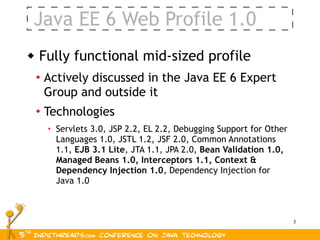







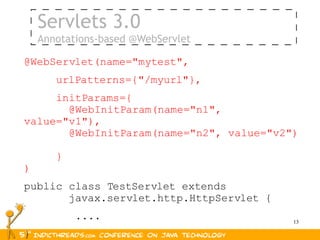





![Servlets 3.0 Resource Sharing
Static and JSP no longer confined to
document root of the web application
May be placed in WEB-INF/lib/
[*.jar]/META-INF/resources
Resources in document root take
precedence over those in bundled JAR
myapp.war
WEB-INF/lib/catalog.jar
/META-INF/resources/catalog/books.html
http://localhost:8080/myapp/catalog/books.html
19](https://image.slidesharecdn.com/indic-threads-javaee6-glassfishv3-dec-2010-101217052423-phpapp02/85/Java-EE-6-Deep-Dive-Indic-Threads-Pune-2010-19-320.jpg)






![EJB 3.1
Portable Global JNDI Name Syntax
Base name of ejb-jar/WAR
Only within EAR (or ejb-jar.xml/web.xml)
Base name of EAR
(or application.xml)
java:global[/<app-name>]/<module-name>/<bean-name>
[!<fully-qualified-interface-name>]
Unqualified name of the bean class
Annotation/name attribute
• Until now, only java:comp Or ejb-jar.xml
• Local & Remote business
• No-interface
• Also in java:app, java:module
26](https://image.slidesharecdn.com/indic-threads-javaee6-glassfishv3-dec-2010-101217052423-phpapp02/85/Java-EE-6-Deep-Dive-Indic-Threads-Pune-2010-26-320.jpg)



















![Java Persistence API 2
Much more ...
New locking modes
PESSIMISTIC_READ – grab shared lock
PESSIMISTIC_WRITE – grab exclusive lock
PESSIMISTIC_FORCE_INCREMENT – update version
em.find(<entity>.class, id,
LockModeType.XXX)
em.lock(<entity>, LockModeType.XXX)
Standard configuration options
javax.persistence.jdbc.[driver | url | user | password]
46](https://image.slidesharecdn.com/indic-threads-javaee6-glassfishv3-dec-2010-101217052423-phpapp02/85/Java-EE-6-Deep-Dive-Indic-Threads-Pune-2010-46-320.jpg)






















![Bean Validation
Integration with JPA
Managed classes may be configured
Entities, Mapped superclasses, Embeddable classes
Applied during pre-persist, pre-update,
pre-remove lifecycle events
How to enable ?
“validation-mode” in persistence.xml
“javax.persistence.validation.mode” key in
Persistence.createEntityManagerFactory
Specific set of classes can be targeted
javax.persistence.validation.group.pre-[persist|
69
update|remove]](https://image.slidesharecdn.com/indic-threads-javaee6-glassfishv3-dec-2010-101217052423-phpapp02/85/Java-EE-6-Deep-Dive-Indic-Threads-Pune-2010-69-320.jpg)

